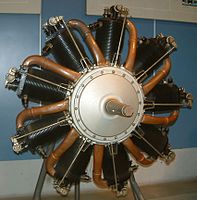
Photo from wikipedia
Abstract Compact and high power density internal combustion engines are attracting much attention for the applications to hybrid vehicles, aiming at decreasing fuel consumption and exhaust emissions. A novel opposed… Click to show full abstract
Abstract Compact and high power density internal combustion engines are attracting much attention for the applications to hybrid vehicles, aiming at decreasing fuel consumption and exhaust emissions. A novel opposed rotary piston engine, whose cyclic period is 360° crank angle, is designed as the power of hybrid vehicles. Intake process of the internal combustion engines significantly affects brake thermal efficiency and rated power. In this paper, 3D simulation of a opposed rotary piston engine is conducted over different engine speeds of 3000 and 5000 RPM, in order to analyze the intake characteristics and pumping loss in the intake stroke. The results indicate that the in-cylinder pressure distributions change significantly in the intake process, which results from the variations of cylinder volume and fresh air flow rates. The minimum in-cylinder pressure is approximately 0.3 and 0.2 bar for 3000 and 5000 RPM, respectively, with the combustion chamber volume (corresponding to minimum pressure) being ∼0.04 L correspondingly. The maximum velocity of the fresh air in the intake process is higher than 150 m/s. Intake valves 2 and 3 dominate the mass flow of the combustion chambers, in addition, the contribution of mass flow from intake valve 1 decreases with the engine speed. The pump loss in the intake process increases from 1.35 to 4.39 kW when the engine speed increases from 3000 to 5000 RPM.
Journal Title: Journal of Cleaner Production
Year Published: 2020
Link to full text (if available)
Share on Social Media: Sign Up to like & get
recommendations!